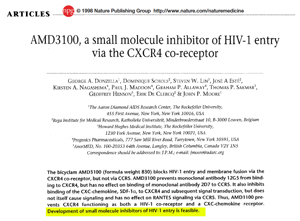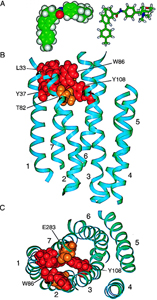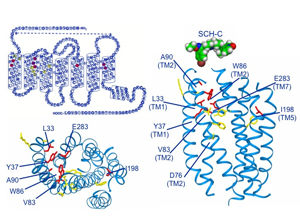|
Summary.
HIV-1, the virus that causes AIDS, infects certain immune system cells. In order to enter a cell, the virus must fasten itself to two receptors on the cell surface. First it binds to a receptor called CD4; then it attaches to either CCR5 or CXCR4. The role of CCR5 and CXCR4 as HIV-1 co-receptors was discovered in 1996. Inspired by that finding, the Sakmar Laboratory began studies of co-receptors with the aim of developing small molecules that could seek out and bind to CCR5 and CXCR4 before HIV-1, thus obstructing HIV-1 from getting into cells. Members of the Sakmar team and their collaborators demonstrated the feasibility of small molecule HIV blockers and provided a foundation for the rational design and optimization of potential drug compounds. Others took this basic research into the clinic. A prototype HIV-1 blocker was tested in clinical trials at the Rockefeller Hospital. Two FDA-approved drugs have been developed partly as a result of Sakmar Laboratory studies—one for treating AIDS (UK-427,825, maraviroc, SelzentryTM), the other used in preparing certain patients for bone marrow transplants (AMD3100, plerixafor, MozobilTM).
Blocking HIV By Targeting Chemokine Receptors.
The Sakmar laboratory had previously studied cellular receptors in another part of the body—light-sensing receptors in the eye’s retina. These receptors, as well as CCR5 and CXCR4, belong to a large family of proteins with a similar structure that snakes back and forth through the cell membrane seven times. Such heptahelical receptors—also know as G protein-coupled receptors (GPCRs)—comprise the largest gene family in the human genome. Heptahelicals are particularly important because they are the targets of more than a quarter of all therapeutic drugs.
The Sakmar laboratory drew on this general knowledge of heptahelical receptors to better understand the biology of CXCR4 and CCR5, which belong to a subset of heptahelical receptors known as chemokine receptors. Many chemokine receptors, including CCR5, interact with immune-system signaling molecules during inflammation. The research of the Sakmar Laboratory—including proof-of-concept, computational models, and laboratory studies to refine the design of prototype drugs—contributed to the development of Maraviroc™, released in 2007, and the first member of a new class of drugs to treat AIDS by blocking cellular entry targeting CCR5, rather than by fighting the virus from inside the cell after infection has occurred.
The search for a molecule to block CXCR4 led in a different direction. In addition to playing a role in the immune response, CXCR4 can direct cell migration. Members of the Sakmar laboratory also studied a prototype for Mozobil™, which received FDA approval in 2008. By blocking CXCR4 function, this drug prevents stem cells from homing to the bone marrow, allowing them to be collected from a patient’s blood in advance of an autologous bone marrow transplant. The aim of targeting CCR5 and CXCR4 and understanding the biology of chemokine receptors relevant to HIV-1 continues to be a main focus of research in the Sakmar Laboratory, along with studies of vision and the retina.
Relevant Publications:
7).
Donzella GA, Schols D, Lin SW, Esté JA, Nagashima KA, Maddon PJ, Allaway GP, Sakmar TP, Henson G, De Clercq E, and Moore JP.
AMD3100, a small molecule inhibitor of HIV-1 entry via the CXCR4 co-receptor.
Nature Med, 1998, 4: 72–77
PMID: 9427609 [PubMed - indexed for MEDLINE]
6).
Dragic T, Trkola A, Lin SW, Nagashima K, Kajumo F, Allaway G, Wu L, MacKay C, Sakmar TP, Maddon PJ, and Moore JP.
N-Terminal substitutions in the CCR5 co-receptor impair gp120 binding and HIV-1 entry.
J Virol, 1998, 72: 279–284
5).
Dragic T, Trkola A, Thompson DAD, Cormier EG, Kajumo FA, Maxwell E, Lin SW, Ying W, Smith SO, Sakmar TP, and Moore JP.
A binding pocket for a small molecule inhibitor of HIV-1 entry within the transmembrane helices of CCR5.
Proc Natl Acad Sci USA, 2000, 97: 5639–5644
4).
Tsamis F, Gavrilov S, Kajumo F, Seibert C, Kuhmann S, Ketas T, Trkola A, Palani A, Clader JW, Tagat JR, McCombie S, Baroudy B, Moore JP, Sakmar TP, and Dragic T.
Analysis of the mechanism by which the small-molecule CCR5 antagonists SCH-351125 and SCH-350581 inhibit human immunodeficiency virus type 1 entry.
J Virol, 2003, 77: 5201–5208
3).
Seibert C and Sakmar TP.
Small-molecule antagonists of CCR5 and CXCR4: A promising new class of anti-HIV-1 drugs.
Curr Pharm Design, 2004, 10: 2041–2062
PMID: 15279544 [PubMed - indexed for MEDLINE]
2).
Billick E, Seibert C, Pugach P, Ketas T, Trkola A, Endres MJ, Murgolo NJ, Coates E, Reyes GR, Baroudy BM, Sakmar TP, Moore JP, and Kuhmann SE.
The differential sensitivity of human and rhesus macaque CCR5 to small-molecule inhibitors of human immunodeficiency virus type 1 entry is explained by a single amino acid difference and suggests a mechanism of action for these inhibitors.
J Virol, 2004, 78: 4134–4144
1).
Seibert C, Ying W, Gavrilov S, Tsamis F, Kuhmann SE, Palani A, Tagat JR, Clader JW, McCombie SW, Baroudy BM, Smith SO, Dragic T, Moore JP, and Sakmar TP.
Interaction of small molecule inhibitors of HIV-1 entry with CCR5.
Virology, 2006, 349: 41–54
PMID: 16494916
Further Reading:
Sakmar TP.
Twenty years of the magnificent seven: With decades of discovery on seven transmembrane receptors, why haven't we saved the day?
The Scientist, 2005, 19(1): 22
Links:
FDA Approves Novel Antiviral Drug
|



|


